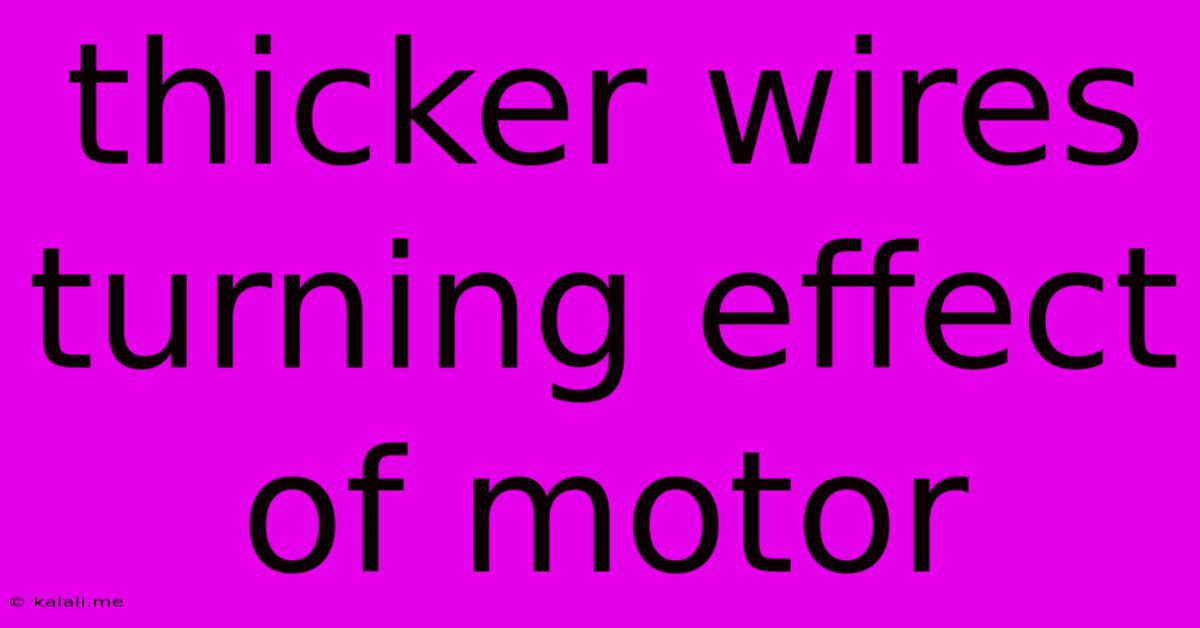Thicker Wires Turning Effect Of Motor
Kalali
Jun 04, 2025 · 3 min read

Table of Contents
Thicker Wires: The Impact on Motor Torque and Performance
This article delves into the often-overlooked relationship between wire gauge and motor performance. Specifically, we'll explore how using thicker wires in motor windings affects torque production and overall efficiency. Understanding this relationship is crucial for anyone designing, building, or troubleshooting electric motors.
Understanding the Role of Wire in Electric Motors
Electric motors rely on the interaction between magnetic fields and current-carrying conductors to generate torque. The windings, made from copper wire, are where this interaction takes place. The current flowing through these wires creates a magnetic field that interacts with the permanent magnets or electromagnets within the motor, resulting in rotational force (torque). The diameter, or gauge, of this wire plays a significant role in this process.
The Advantages of Using Thicker Wires
Thicker wires, with lower resistance, offer several key advantages:
-
Increased Current Carrying Capacity: The most significant benefit is their ability to handle higher currents without excessive heating. Thinner wires have higher resistance, leading to more heat generation at the same current. This heat can significantly reduce the motor's efficiency and even damage the insulation. Using thicker wires allows for higher current flow, translating to greater torque output.
-
Reduced Losses: Lower resistance means lower power loss due to heat. This translates to higher efficiency, meaning more of the electrical input power is converted into mechanical output power. This is particularly important for applications requiring high power or continuous operation.
-
Improved Motor Efficiency: By reducing resistive losses, thicker wires contribute to a higher overall motor efficiency. This efficiency improvement is particularly beneficial in applications where energy consumption is a major concern.
-
Enhanced Torque: The ability to handle higher currents directly translates to higher torque production. This is crucial for applications needing strong starting torque or high power output at low speeds. Think high-torque applications like electric vehicles or industrial machinery.
The Trade-offs of Thicker Wires
While thicker wires offer substantial benefits, there are also some trade-offs to consider:
-
Increased Cost: Thicker copper wire is more expensive. The cost increase needs to be balanced against the benefits gained in terms of performance and efficiency.
-
Increased Winding Space: Thicker wires require more space within the motor windings. This can lead to a larger and potentially heavier motor, affecting overall design and packaging constraints.
-
Potential for Increased Winding Resistance (in certain cases): While thicker individual wires have lower resistance, increasing the number of turns in a winding (to maintain the same number of Ampere-Turns) with thicker wires can potentially lead to slightly higher overall winding resistance. Careful design is crucial.
Choosing the Right Wire Gauge: A Balancing Act
Selecting the appropriate wire gauge for a motor involves carefully balancing the benefits of increased current capacity and reduced losses with the increased costs and physical size limitations. Factors to consider include:
-
Motor application and required torque: High-torque applications usually justify the use of thicker wires.
-
Operating current: The maximum current the motor will draw determines the minimum wire gauge required to avoid overheating.
-
Available space within the motor: Physical constraints can limit the thickness of the wire that can be used.
-
Cost considerations: The cost of the wire needs to be weighed against the benefits gained in terms of performance and efficiency.
Conclusion:
The choice of wire gauge significantly impacts motor performance. While thicker wires inherently lead to improved torque, efficiency, and reduced heat generation, the trade-offs related to cost and physical size must be taken into account. A careful analysis of the application requirements is crucial to selecting the optimal wire gauge for a given motor design. Understanding this crucial relationship allows engineers and hobbyists to optimize motor design for maximum performance and efficiency.
Latest Posts
Latest Posts
-
Can You Remove Envoys Civ 6
Jun 06, 2025
-
How To Transfer Player Inventory From World Minecraft Server
Jun 06, 2025
-
Can Pyrex Go In The Freezer
Jun 06, 2025
-
Can You Pray Fajr After Sunrise
Jun 06, 2025
-
Use A Laptop As A Monitor
Jun 06, 2025
Related Post
Thank you for visiting our website which covers about Thicker Wires Turning Effect Of Motor . We hope the information provided has been useful to you. Feel free to contact us if you have any questions or need further assistance. See you next time and don't miss to bookmark.